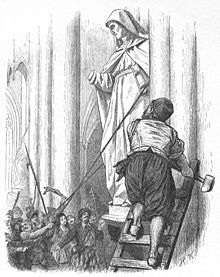The recall of the Virgin of Barby
The recall of the Virgin of Barby is a story by Gertrud von le Fort , which was published in 1940 by Michael Beckstein in Munich.
Magdeburg on June 5, 1524: Jungfrau Mechthild von Barby from the Barbyschen Winkel has a vision. The nun foresees the storm on the pictures of her St. Agneten monastery in Magdeburg. After the Münzerischen predicants at the head of incited Magdeburgers have leaned the scaling ladder against the window of the Virgin of Barby, the nun perishes .
title
The author gives the word recall a double meaning . First, the tall, tall, noble Virgin of Barby is recalled by God with an open table in the midst of all the nuns. She has a face . The virgin dies last. This is perpetual recall.
history
The author retells a story from the chronicle of Sebastian Langmann. On the day of St. Boniface's death , a gang of sulfur under Grewe Köppen invades the Agnetenkloster in Magdeburg. Köppen, a monk from Helmstedt , was very popular in the spring of 1524 when he preached on the subject of Protestantism in Sudenburg .
Gertrud von le Fort also gives oral evidence of this. A nun is said to have died in the attack on the monastery.
content
On St. Norbert's Day , the abbess wants to show the Magdeburgers all the jewels and other sanctuaries from the treasury of the Agnetenkloster during the service. Because their enemy Grewe Köppen has spread a rumor in the city. The abbess had the treasures removed from the treasury. The provost strongly advises against showing it. In Halberstadt , from Osterwieck to Aschersleben , the altars have already been plundered by the swarming spirits. The abbess cannot be changed. The provost, who otherwise gets along with all the high-ranking gentlemen up to the Archbishop of Mainz , is no match for this resolute woman. He leaves the monastery. The abbess has a free hand.
The Virgin of Barby has a vision. When asked about the apparition by her abbess, the maiden confesses that she foresaw those dismaying events on the day her monastery was stormed. All pictures of the monastery would have been "destroyed" in the face. The virgin no longer has a Heavenly Father or even an image of God. That is too much for the angry abbess. The virgin is imprisoned in her cell as a punishment.
The abbess lets the news spread among the Magdeburgers that the jewels will be shown on St. Norbert's Day. Grewe Köppen storms the nunnery with the "idols".
Quote
- Meister Eckhart : "God gives birth to himself in man and passes away with him."
reception
- The novella was written in memory of two famous Magdeburgers. What are meant are St. Norbert and the mystic Mechthild von Magdeburg .
- Symbolism: As early as 1940 the author speaks of the "absence of God" when she castigates brute force, such as the storming of a monastery.
- Iconoclasm - time of rebellion: Reinhold Schneider describes the vision of the Virgin of Barby as a counter-image to the Reformation. The nun is called to such a distance from God that the image of God is extinguished for her and her soul sinks down to the beggars and those forsaken by God.
- Gerd Vielhaber admires the brilliance of the language in the brief novella and means the moderate chronicle style.
literature
- expenditure
- Gertrud von le Fort: The recall of the Virgin of Barby. Michael Beckstein Verlag, Munich 1940. With blurbs by Reinhold Schneider and Gerd Vielhaber .
- Gertrud von le Fort: The recall of the Virgin of Barby. Benziger, Einsiedeln et al. 1948.
- Secondary literature
- Nicholas J. Meyerhofer: Gertrud von LeFort (= heads of the 20th century. Vol. 119). Morgenbuch-Verlag, Berlin 1993, ISBN 3-371-00376-0 .
- Gero von Wilpert : Lexicon of world literature. German authors A - Z. 4th, completely revised edition. Kröner, Stuttgart 2004, ISBN 3-520-83704-8 , p. 382.
Web links
- Short synopsis at the literary society Gertrud von le Fort
- Kurt Faßbender: The visions of Mechthild von Magdeburg and the virgin von Barby (PDF; 124 kB) from June 2000
